Knives With Corkscrews
An Historical Look
by Clyde Shoe
GENESIS
Picture the pieces starting to come together some three hundred years ago. First there was the growing interest in aged wine, a product requiring snug stoppers. Flexible, air-tight cork bark could achieve this, but only if pressed against an uniformly smooth surface. The new glass bottles being developed were starting to be smooth and uniform. Other liquids like cider, beer, medicinals, perfume and the ultimate stopper challenge, champagne, all needed tight closure.
Andre Simon, Bottlescrew Days, 1926: “The corkscrew is to the cork what the key is to the lock. Who invented the corkscrew? No one knows. It is obvious that very soon after the use of cork was introduced, the corkscrew, or as it was known at the time, the ‘bottle screw,’ must have been introduced: otherwise the glass bottle would not have been the restful home of the wine, but its lifelong prison.” (Taken from Ref. 1)
The first corkscrew was likely a simple twist of wire, or an expediently used gun tool worm. The screw part of the corkscrew, called a “worm” or a “helix” if wire made, has changed the least over the centuries. The other part, the shaft and the rest, has benefitted or suffered from thousands of “improvements.”
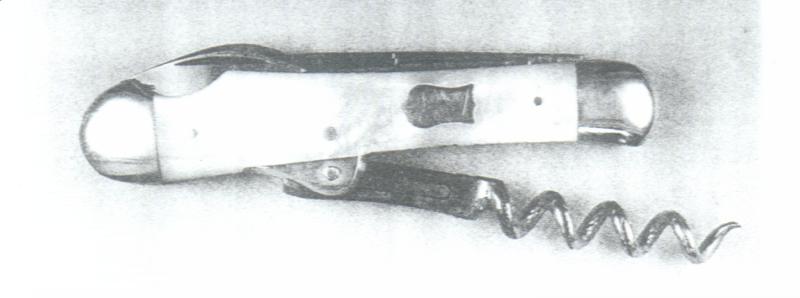
Adolph Kastor 1897 A slotted shank allows a full length worm to retract into the frame. Courtesy Fred O’Leary (Ref.2)
THE MARRIAGE
The evidence is that the knife and corkscrew first came together in the 18th Century. Bert Giulian, author of Corkscrews of the Eighteenth Century, graciously responds to my question: “I believe the earliest combination. . . was the pipe tamper on the base of the sheath as early as the late 17th Century. Other combinations are found in the early mid-18th Century, and I am not aware of any knife combinations prior to mid-18th Century. By the late 18th Century the combination of corkscrews with knives and other implements is relatively common.”
In Bert’s book, I found this, taken from Philadelphia’s Pennsylvania Gazette, May 24, 1750: “James Wallace just imported from Liverpool, at his store opposite the Queen’s Head, in Water Street, near Chestnut Street, knives with gunscrews.”
Gunscrews are, well, close to corkscrews, wouldn’t you say?
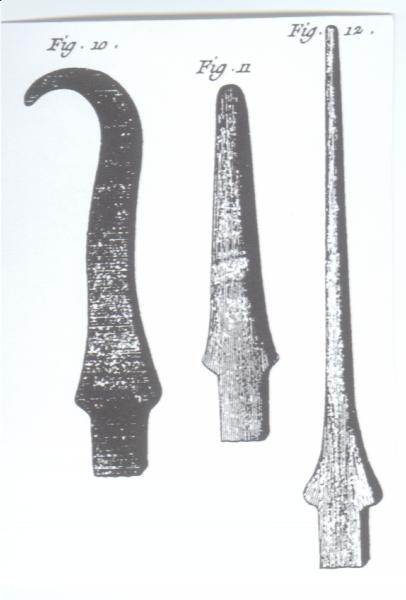
French 18th Century hook and blade cork pullers. Courtesy Bert Giulian (Ref.1)
HOOKERS
I assumed that the cork-puller hook predated the worm, since to my eye, the hook looks so primitive. It turns out that probably the worm came first. Although it never worked all that well, new versions of the hook keep popping up (even though hooked corks often don’t.) Design patent D-296,755 was issued July 19, 1988 for a cork-puller hook–centuries after the first one mangled a cork. (Ref. 2) Hook inventors never give up.
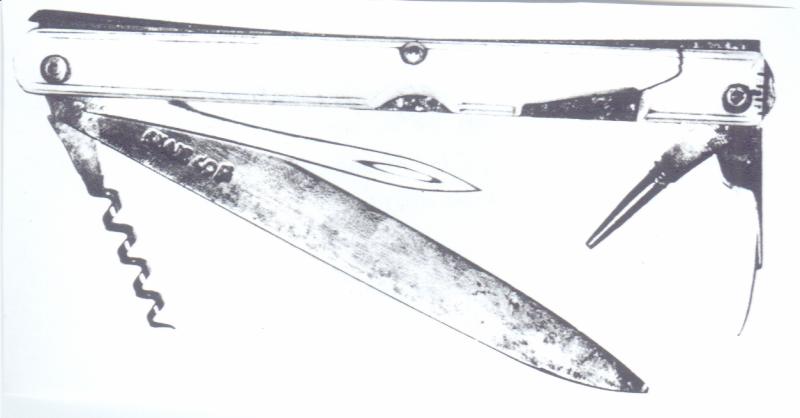
French c1780 veterinary knife 6-3/8″ closed. Bone handles, flat ribbon helix, seton needle, makers mark on master, leather punch, spay. Courtesy Bert Giulian (Ref.1)
STATE OF THE ART
I’ve always considered the pulling of a cork to be an ordeal–at best a trial, at worst wine spilled on me and the tablecloth, with cork crumbs floating in what’s left. There are over one thousand U. S. corkscrew patents and unknown hordes of foreign ones. It’s like that old saw, “Where there are many remedies, there is none.” If a corkscrew could talk, it might defend itself by declaring, “it’s the cork, stupid.”
Fitzgerald’s poem, The Rubaiyat of Omar Khayyam, sets a promising scene:
“A Jug of Wine, a loaf of Bread–and Thou Beside me singing in the Wilderness.”
By the time you get a stubborn cork out with the short worm on your pocketknife, you might not have any energy left for Thou. The world markets cry out for a lever-assisted corkscrew built onto a knife. If I invented one, I could make my fortune by sales to grateful Thous alone!
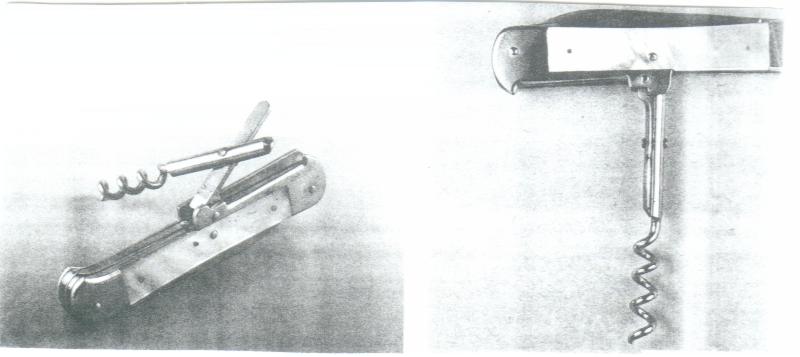
Open and part opened views of same knife. Hammesfahr Pat. 1898. The split shank allows additional length. Courtesy Fred O’Leary (Ref.2)
A corkscrew firmly attached near the middle of a pocketknife can only be half the length of the knife, unless the worm point sticks out beyond the bolster. Pulling a tight cork with a short worm is not easy, and you don’t want a close audience.
The breakthrough came by devising a ways of sliding the corkscrew toward the end of the knife for retraction, then back to the middle for cork extraction. What was needed was more than could be provided with a joint. Heretofore corkscrews had been put on a knife as an appendage. Then in the 1890’s, for the first time, “. . . the inventors had a singular purpose in mind, which was to engineer a pocketknife onto a corkscrew.” (Ref. 2) It now was a pocketknife that was the appendage.
The Germans were the first to set sail on this course, with two U. S. patents before the turn of the Century. Remington Arms bobbed along in their wake some 30 years later.
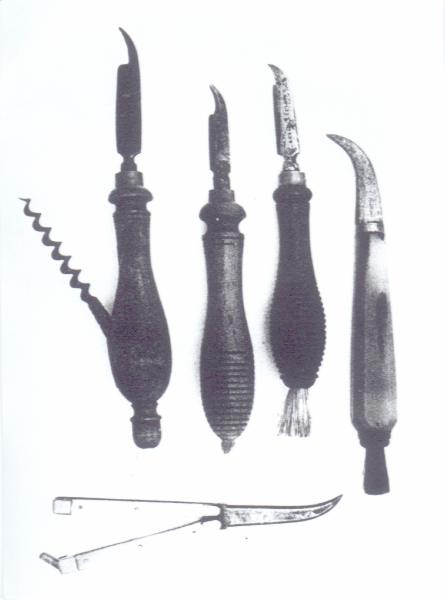
Early champagne knives. Brush is for fastidious types who don’t like grit in their wine. Courtesy Don Bull (Ref.3)
MARKETING 101
German cutlers were not only ingenious inventors but were aggressive marketers. Bert Giulian offers the astounding revelation that 19th Century Solingen firms exported corkscrews to Sheffield, England for assembly on Sheffield knives. It is astounding because 19th Century Sheffielders hated German cutlers. They hated them because the Germans counterfeited Sheffield trademarks; and they hated them because the Germans competed on the American market with cheaper goods, a market that Sheffield cutlers had always considered their private patch. Commerce, then as now, makes for strange bedfellows.
Strangeness then got even stranger. Foreign machine-made cutlery so discombobulated Sheffield cutlery firms that at the same time they were suing foreign offenders for copyright infringement, they were importing blanks from Germany which they stamped “Sheffield.” What would you call that, reverse counterfeiting?
I once saw a “Sheffield” marked corkscrew knife with the wire helix stretched to half again its original length, no doubt from a seized cork. Could this corkscrew have been a German masquerading as an Englishman? I hope it wasn’t an example of Sheffield’s celebrated hand- made quality.
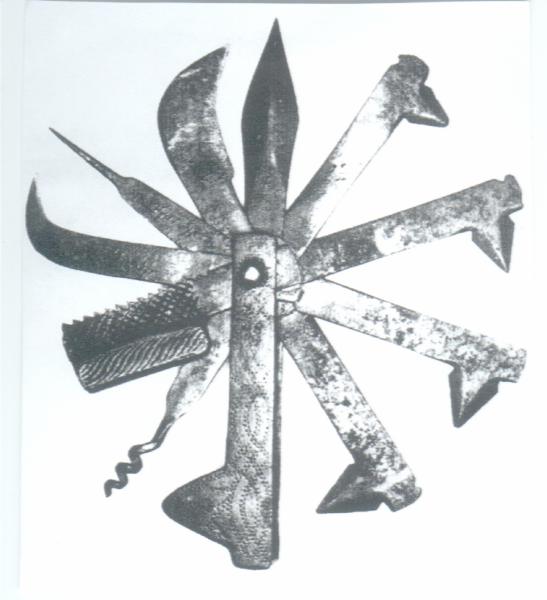
Spanish or French c1800. Fleams for bleeding animals. Lancet for bleeding humans. Broad tool is a hoof rasp. Courtesy Bert Giulian (Ref.1)
TECHIE STUFF
There are two basic types of corkscrew spirals. Looking at the wire helix from the business end, you will see that it has an open center. The other design is a worm twisted from a flattened strip of metal, filed to a cutting edge. Looking at its business end, you will see a solid core. Long ago the English specialized in open centers, continental cutlers in solid centers, with America an inherited mix of both. This geographic distinction has become blurred over time. Now it is a mishmash everywhere.
My favorite is a solid core variation called the Archimedean worm, an auger of metal thread spiraling down a tapering rod. It is so called because in silhouette it resembles the great inventor’s 200 B.C. waterscrew. I grieve that this variant never seems to be found on pocket knives.
Sometimes grooves, single or double, are seen on the outside of the worm or helix. Grooves ease cork penetration and improve grip. Grooves look good, too. Double grooves or fluting are especially desired.
Did you know that there are separate corkscrews for right and left-handers? I didn’t. The biting screw is turned clockwise for right-handed users, and counterclockwise for lefties. I didn’t know handedness made a difference. Nobody ever asked me what I needed. I am left-handed and have only right-handed corkscrews. Hmmm. Maybe that’s why I mangle so many corks.
Fred O”Leary’s welcome letter tells us that left-handed corkscrews are rare, making up less than one percent of his collection, and he hunts hard for them. Fred goes on to say that, “The only pocketknives I am aware of offering a left-hand worm are Swedish. Some are known to have up to six worms, one or more of them left-handed.”
Holy Toledo! Six worms on one knife–a Gatling gun for corks! This corkscrew business is screwy.
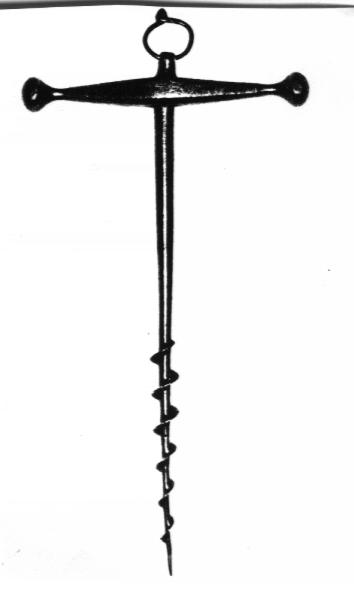
Archimedian corkscrew. French 1700. Courtesy Bert Giulian (Ref.1)
TRIVIA
U. S. corkscrew patents have been issued to inventors in 49 states, including six to Oregon residents and 14 to Washingtonians. Mississippi is the only state in the Union with residents apparently satisfied with their corkscrew status quo. They have zero patents. (Ref. 2) Maybe Mississippians drink their wine only from screw-top bottles.
SOURCES
Corkscrew fans are blessed with splendid references. Looking at the elegance of even simple pieces pictured in Bertrand Giulian’s book will remove any bias about early metalwork being crude or primitive. Bert packages these treasures well in their historical context. History is my bent, so I like his book a lot. Corkscrews of the Eighteenth Century – Artistry in Iron and Steel. 1995 e-mail giulian@kp.net (Ref. 1)
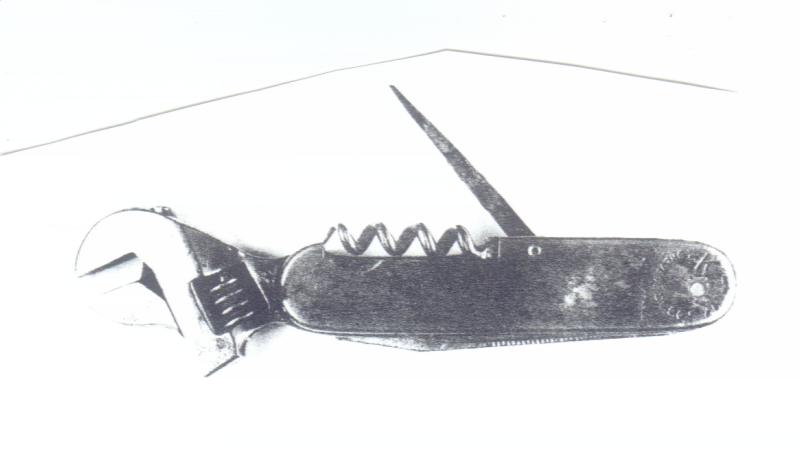
French 1931 K.T.K. Note grooved worm. Courtesy Fred O’Leary (Ref.2)
Fred O’Leary give us fascinating views and commentary about American patented corkscrews since 1860, and a thorough grounding in the patent process itself. Fred says he should be “booked for impersonating an author.” If that is what it takes to have his writing skill, would that I had his rap sheet. Corkscrews, 1996. e-mail fsoleary@aol.com . (Ref. 2)
Don Bull has a new work which he modestly calls The Ultimate Corkscrew Book, Jan 1999. email corkskrue@aol.com . With 477 knives photographed, it may well be the “ultimate” corkscrew book for knife fanciers. I want to see it bad. You have got to love a corkscrew author who devotes a big piece to knives. A few of Don’s prepublication photos are in this article. (Ref. 3)
With synthetic corks and aluminum closures on the horizon, Fred O’Leary writes that time is on the side of technology, not tradition, and that corkscrews may be on the endangered list.
If you are thinking corkscrew knives for your collection, let us end on this uplifting note: Corkscrew fanciers never die. They are pulled from us by the Great Extractor.
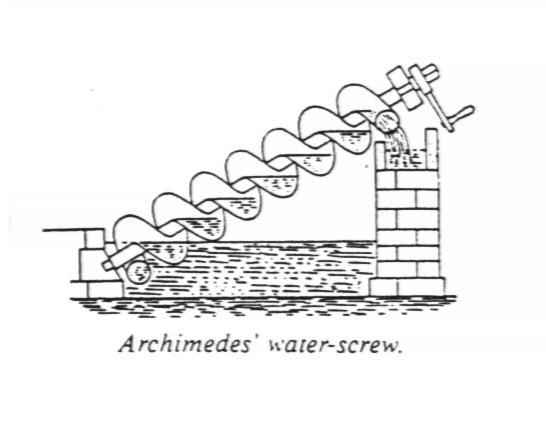
200 B.C. Courtesy Fred O’Leary (Ref.2)
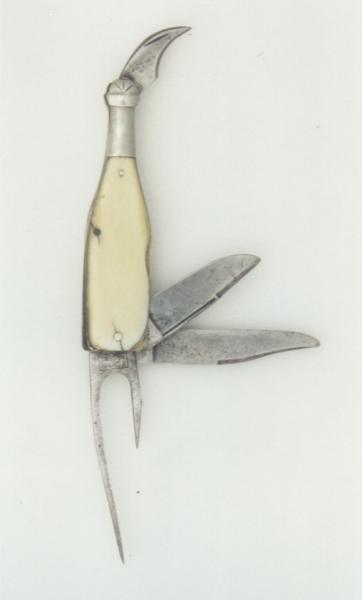
Korn’s patent 1883. A champagne pattern. The curved blade is a wire breaker. Prongs turn the cork which then can be worked out. Courtesy Don Bull (Ref.3)
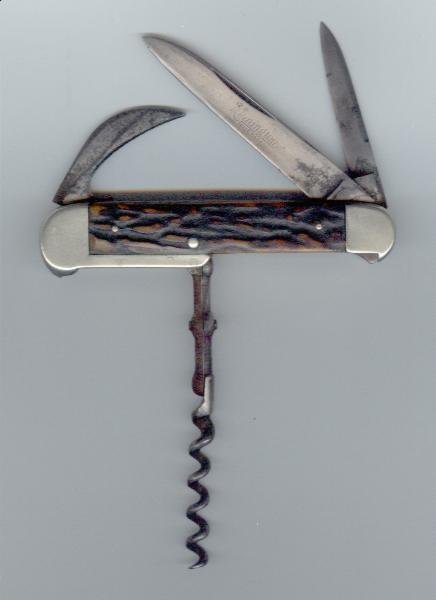
Remington 1929. A double-pivot split-shank worm. Courtesy ibdennis

Gun tool worm. Rome 1621. Courtesy Bert Giulian (Ref.1)
Editor: In one of the notes from Clyde he wrote the following quote from W. C. Fields, which I would like to share: Like W. C. Field’s trip to Afghanistan: “We lost our corkscrew and were forced to survive for several days on food and water.”
Copyright (C) 1999 Oregon Knife Collectors Association. No part of this article may be reproduced without permission of the OKCA.
